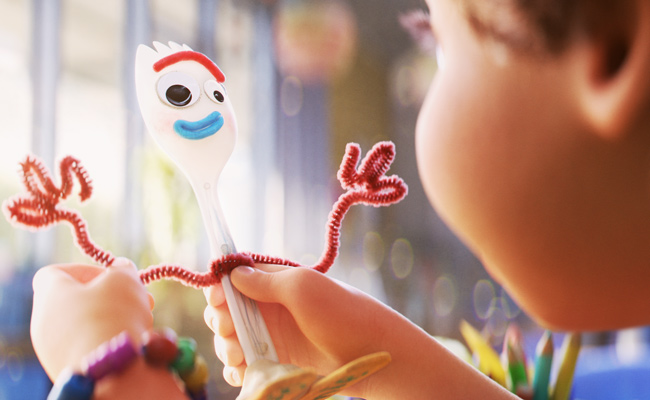
One of the greatest tricks the Toy Story franchise ever pulled was turning what on the surface looks like this consumerist paean to stuff into a poignant riff on mortality. This came to a head with the incinerator scene in Toy Story 3, when the characters hold hands while facing down the inevitability of death, a scene that should be laughable coming from anthropomorphized toys in glorified toy company movie but nonetheless gets me embarrassingly sniffly every time. The Pixar boys managed to flip the concept so that it wasn’t about stuff per se, but a bittersweet riff on the ephemeral nature of childhood. Not exactly a brand new idea for children’s entertainment (Winnie The Pooh, The Giving Tree, Peter Pan, et al), but a pretty well-played trick nonetheless.
Where to go from there? In Toy Story 4, the franchise transitions from fear of death to exploring the desire for it. Our hero, Woody the wind-up cowboy, has been passed down from his original owner, Andy — having gone off to college — to Bonnie, who seems to prefer other toys to Woody (including, Jessie, the female version of Woody voiced by Joan Cusack). In a last-ditch effort at relevance, Woody stows away in Bonnie’s backpack on her first day of kindergarten, hoping to catch her eye at an emotionally vulnerable time. Which frankly seems like kind of a fuckboi move. (is Woody a fucktoi? Discuss.) Only instead of turning to Woody for solace, Bonnie constructs for herself a new toy out of a spork, a pipe cleaner, a broken popsicle stick, and some clay, a character she names “Forky.”
Following its own narrative rules, in turning trash into a toy, Bonnie has inadvertently made Forky sentient. And Forky, rather than being excited about his promotion from presumably inanimate pieces of garbage to full consciousness and favored toy status, now desperately wants to go back to being insensate trash. Woody spends basically the next 20 minutes of screen time trying to get Forky to be the toy Bonnie wants him to be and stop him from jumping into garbage cans (Forky returning to his grave, essentially).
Can we pause here to recognize how wonderfully dark this storyline is? I don’t know what I expected from a fourth Toy Story movie, but it was not Woody trying to coax other sentient toys away from death’s dank embrace. Was this a not-so-subtle comment on capitalism-as-death-cult? Uh… I mean, I doubt it, but it’s still kind of awesome.
Having peered into this abyss, Toy Story 4 chooses (wisely, probably) not to spelunk in it, and instead becomes a kind of love story between Woody and Bo Peep (voiced by Annie Pots) who has flourished after being discarded by Bonnie. Rather than being devastated, Peep has traded the love of one child for more temporary dalliances with a series of kids at the local park. She has never seemed happier, and Woody, her erstwhile beau, is both intrigued and intimidated by Bo’s brashness and sexual agency.
The two team up to rescue Forky from a terrifying secondhand store, where an old-fashioned doll (voiced by Christina Hendricks) commands a platoon of zombie-like ventriloquist dummies and wants to lure Woody there so that she can cut him open and steal his voice box. That her own voicebox no longer works is, she believes, the reason she has never experienced a child’s love.
Toy Story 4‘s use of horror movie staging is as excellent as its use of slapstick and just as funny. Helping them in this venture is “Duke Caboom,” voiced by Keanu Reeves, “Canada’s greatest stuntman,” and the second in a row of Keanu Reeve’s wildly successful comedic cameos (after Always Be My Maybe) .
Toy Story 4 goes so damned deliciously dark that when it finally delivers its not-especially-novel message of no-toy-left-behind and self-sacrificing compassion for all, it feels much more natural and poignant, less maudlin than it might have otherwise. Even kids’ movies nowadays have a bad habit of just discarding their villains and chucking them down the disposal when they’ve served their purpose and are no longer needed — something I’m sure grows out of lazy writing, but manifests as mildly evil. One of childhood’s most important lessons is that “bad guys” are mostly just flawed people with screwed-up motives rather than actual demons.
Toy Story 4 works overtime to find the humanity in all its characters, even the scary ones, despite the fact that it exists in a world of sentient toys and anthropomorphic garbage. That is not only endearingly sweet, but kind of wild.
Vince Mancini is on Twitter. You can access his archive of reviews here.






